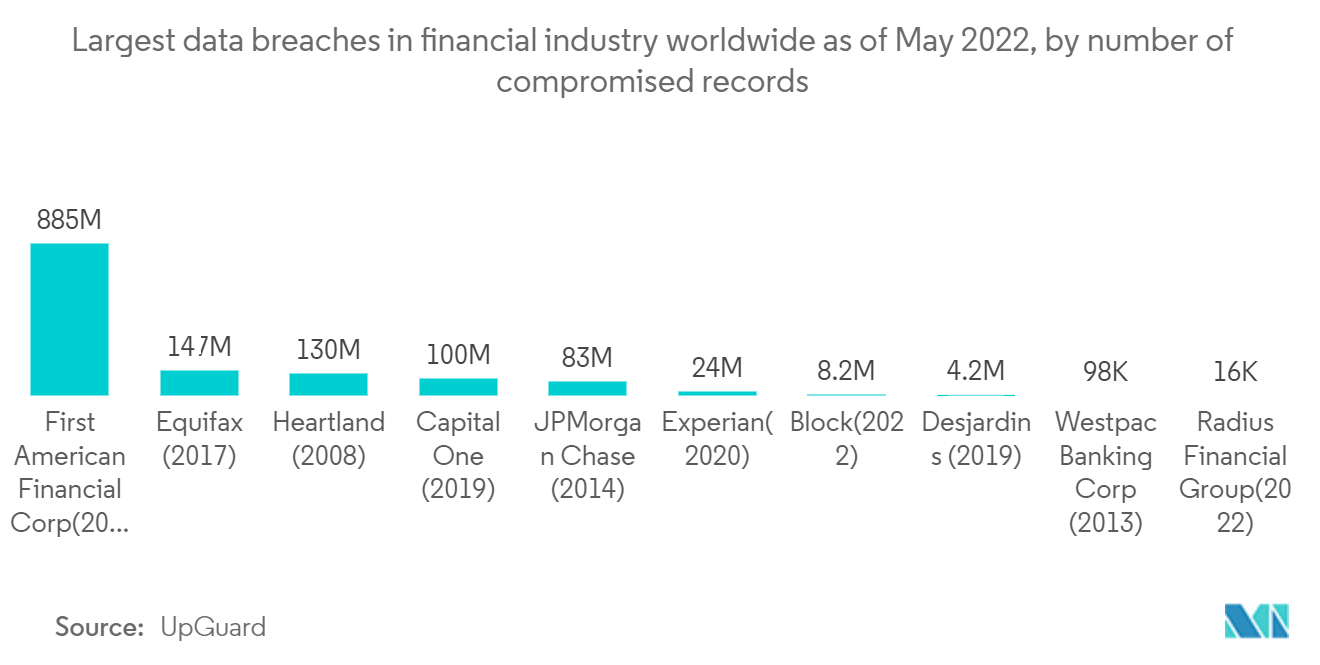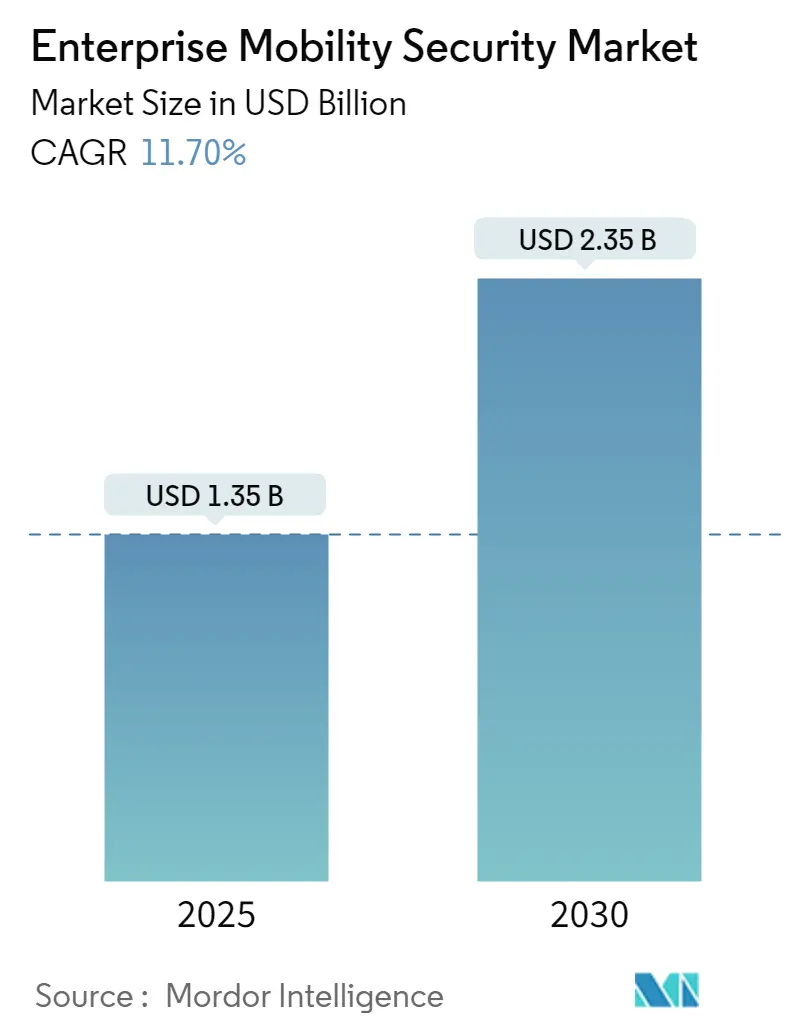
| Study Period | 2019 - 2030 |
| Market Size (2025) | USD 1.35 Billion |
| Market Size (2030) | USD 2.35 Billion |
| CAGR (2025 - 2030) | 11.70 % |
| Fastest Growing Market | Asia Pacific |
| Largest Market | North America |
| Market Concentration | Medium |
Major Players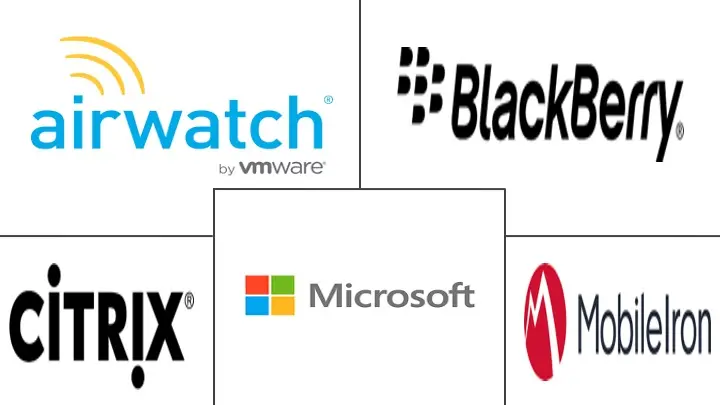
*Disclaimer: Major Players sorted in no particular order |
Enterprise Mobility Security Market Analysis
The Enterprise Mobility Security Market size is estimated at USD 1.35 billion in 2025, and is expected to reach USD 2.35 billion by 2030, at a CAGR of 11.7% during the forecast period (2025-2030).
Enterprise mobility or business mobility is recognized as the growing trend among businesses to offer remote working options, which also allows the use of personal mobile/laptop devices for business purposes and makes efficient and effective use of cloud technology for data access.
- The enterprise's adoption of cloud-based services has been a massive enabler for vendors, as this provides the flexibility of delivering solutions that can be offered based on the number of users and can also be updated without disrupting the services while doing so. Since these solutions are difficult to switch from one solution provider to another, the competition in getting new customers is high. It requires a considerable amount of time and money to create an infrastructure that can be supported.
- The vendors in the market studied offer cross-platform support for their solutions to address the need of enterprises to support multiple device types used by their employees. Android, Windows, iOS, macOS, and Samsung Knox are a few such platforms that are supported. The EMS can provide secure business productivity by providing either or all these services, such as a unified launcher to access all apps, secure browser, email, calendar, contacts or cards, separate corporate identity on personal devices, secure instant messaging, secure notes, and access to cloud-stored files.
- In a modern workspace, where bring-your-own-device (BYOD) and mobility scenarios are gaining increased significance, EMS helps IT administrators meet the challenges of data protection and risk management. Additionally, the introduction of 5G is expected to shape the landscape of enterprise mobility further. This is because 5G will be able to make remote work faster and easier. It will provide a more reliable experience and will also offer businesses and their employees greater flexibility.
- Market vendors face challenges in the market as multiple enterprises have legacy OS still functional in their enterprises. Such challenges make it necessary for the market players to provide support for older versions of OS as a one-time switch cost to a new platform, making it a complicated option for multiple vendors to offer solutions with minimum price.
- The spread of COVID-19 increased the demand for EMS solutions. According to Owl Labs, about 16% of global companies are fully remote, whereas 40% offer in-office and remote work, which is in line with what most employees prefer. This number is expected to increase soon as companies embrace the work-from-home culture.
Enterprise Mobility Security Market Trends
Banking/Insurance Industry to Hold Significant Market Share
- Banking/insurance services have been experiencing a business transition with digitization, internet services, and international transactions require fast redressal. Banking, financial services, and insurance (BFSI) have evolved from being a service that requests the customers to visit for the service to a bank that reaches customers at their homes. BFSI stores critical financial and personal data of the customer and clients and uses them to provide services. This creates a threat for security breaches across financial institutes of many countries worldwide. For instance, in August 2022, according to the government of India, the country reported 248 successful data breaches in the banks, out of which Private sector banks reported 205 data breaches, while PSBs reported 41.
- With the changing banking ecosystem, the banking officers need to access the core services on the move and use public network connectivity services to create a unique user experience. Emerging technologies, such as blockchain and voice command integration, are expected to emerge as mainstream for the BFSI over the forecast period, with multi-factor authentication becoming a norm in the market segment.
- Financial institutions employ a modern cybersecurity approach, the Zero Trust model through EMS. Adopting this model can help banks strengthen their security posture, so they can confidently support initiatives that give employees and customers more flexibility.
- The adoption of EMS has been majorly driven owing to the need to meet security compliance in the BFSI sector. Device provisioning, for instance, aids the BFSI organizations in remotely configuring mobile devices and providing access to corporate data resources and enterprise apps. BFSI apps include tools, such as wealth management, mortgages, and insurance, which the employees need to access financial apps through the tablets outside the banks to connect to the customers, which requires EMS software for security purposes, hence driving the market.
- The market segment's opportunity is majorly in the small-scale and cooperative banks, which still have the scope for digitization and adoption of such services. The emergence of video-based banking services is expected to create an opportunity for enterprise-level banking and insurance businesses.
Asia-Pacific to Witness the Highest Growth
- The Asia-pacific region consists of many emerging economies, and increasing digitalization trends across industries in the region is creating an opportunity for the Enterprise mobility security market because due to digitalization and decentralization of business process for flexibility, the usage of many mobile devices such as smartphones, laptops, and tablets are increasing in the services.
- Additionally, according to the Asia-Pacific digital transformation report published in August 2022 by the United Nations, the mobile industry has made yearly investments in services, infrastructure, and other advancements over the past five years. More than USD 400 billion of this total was invested in Asia and the Pacific. As a result, the countries of the Asia-Pacific are becoming more connected to one another and to the rest of the globe, which is fuelling the market growth in the region.
- Companies in the Asia-Pacific region are embracing BYOD to increase employee satisfaction and productivity, especially in China and India. The growth in high-speed network coverage and smartphone adoption leads to a surge in the use of mobile data in Asia-Pacific.
- Banks have activated remote working tools, allowing their employees to work from home. Financial service providers have deployed live-stream events moving from physical to virtual customer events, and online training for remote servicing is picking up. However, these kinds of scenarios are expected to increase the demand for mobility security services.
- The adoption of 5G in government administration supports the development of smarter utilities, cities, and public safety agencies. Central banks are using the underlying technologies, such as blockchain, and they support the use of technology to encourage further innovation. Due to 5G and AI, every industry is evolving; the government can increase its transportation productivity by implementing smart transportation technologies and connected vehicles. Digital connections have also given society a whole new way to help people. This trend of adoption of smart technology increases the risk of security breaches in the region, which is creating an opportunity for the enterprise mobility security market across various end-user industries in the region.
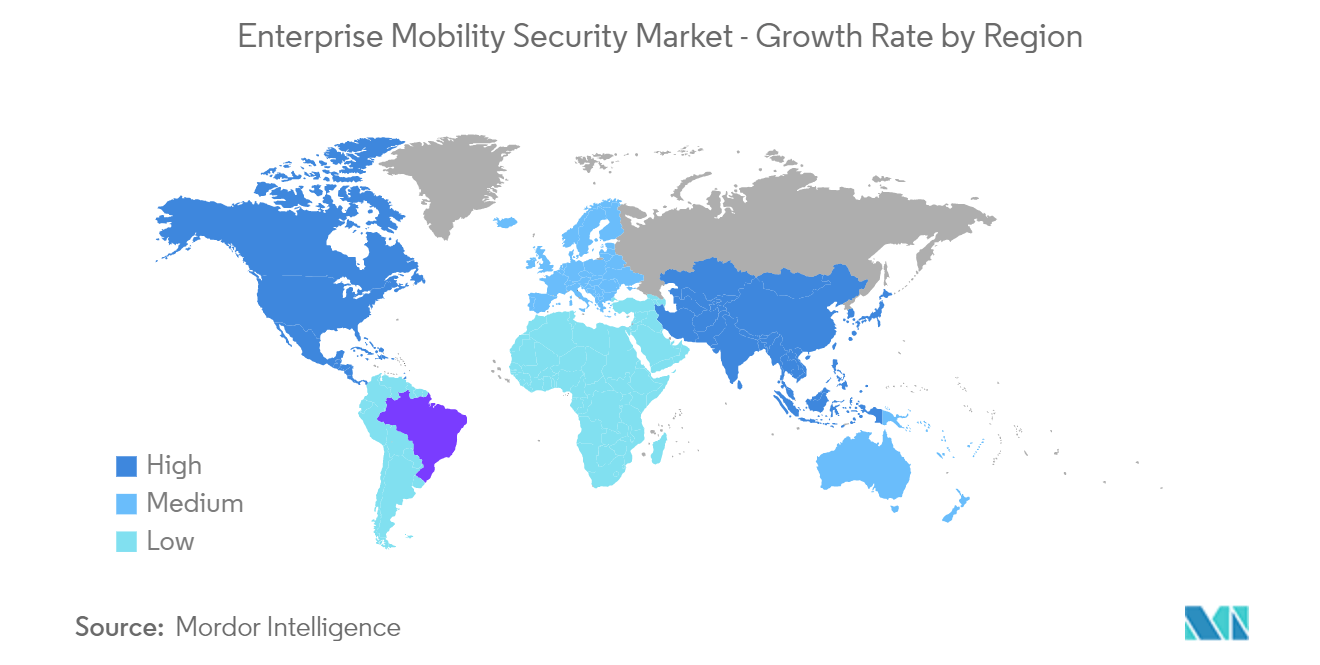
Enterprise Mobility Security Industry Overview
The enterprise mobile security market needs to be more cohesive. Players in the market adopt strategic initiatives such as mergers and acquisitions, partnerships, and new product offerings due to increasing awareness regarding mobility security among enterprises. Some of the recent developments in the market are:
In October 2022, SyncDog Inc, the leading Independent Software Vendor for mobile security and data loss prevention, announced a partnership with 3Eye Technologies to accelerate the development of a more innovative, more complex product for its mobility and cloud strategy. SyncDog would leverage 3Eye Technologies' distribution capabilities through these partnerships to build upon its growing market presence and engage with more customers across new commercial markets and nations.
In August 2022, CWSI, a mobile and cloud security company in Ireland, acquired mobco, a modern workplace and mobility firm located in Dilbeek, Belgium, and Capellen, Luxembourg. Due to the acquisition, the customers of mobco would have access to the extensive technical resources and expertise of CWSI, including its dedicated Microsoft Security Practice, which has been supported by CWSI's Microsoft Gold Security competency and membership in the Microsoft Intelligent Security Association.
In July 2022, Jamf, an Apple-focused mobility provider, partnered with Microsoft's enterprise mobility security to offer Mac security for using Macs in Enterprise applications. Due to these partnerships, organizations could verify user credentials and check the Mac has been managed and compliant using Microsoft EMS and Jamf Mac management before allowing access.
Enterprise Mobility Security Market Leaders
-
Blackberry
-
MobileIron
-
AirWatch
-
Citrix Systems Inc.
-
Microsoft Corporation
- *Disclaimer: Major Players sorted in no particular order
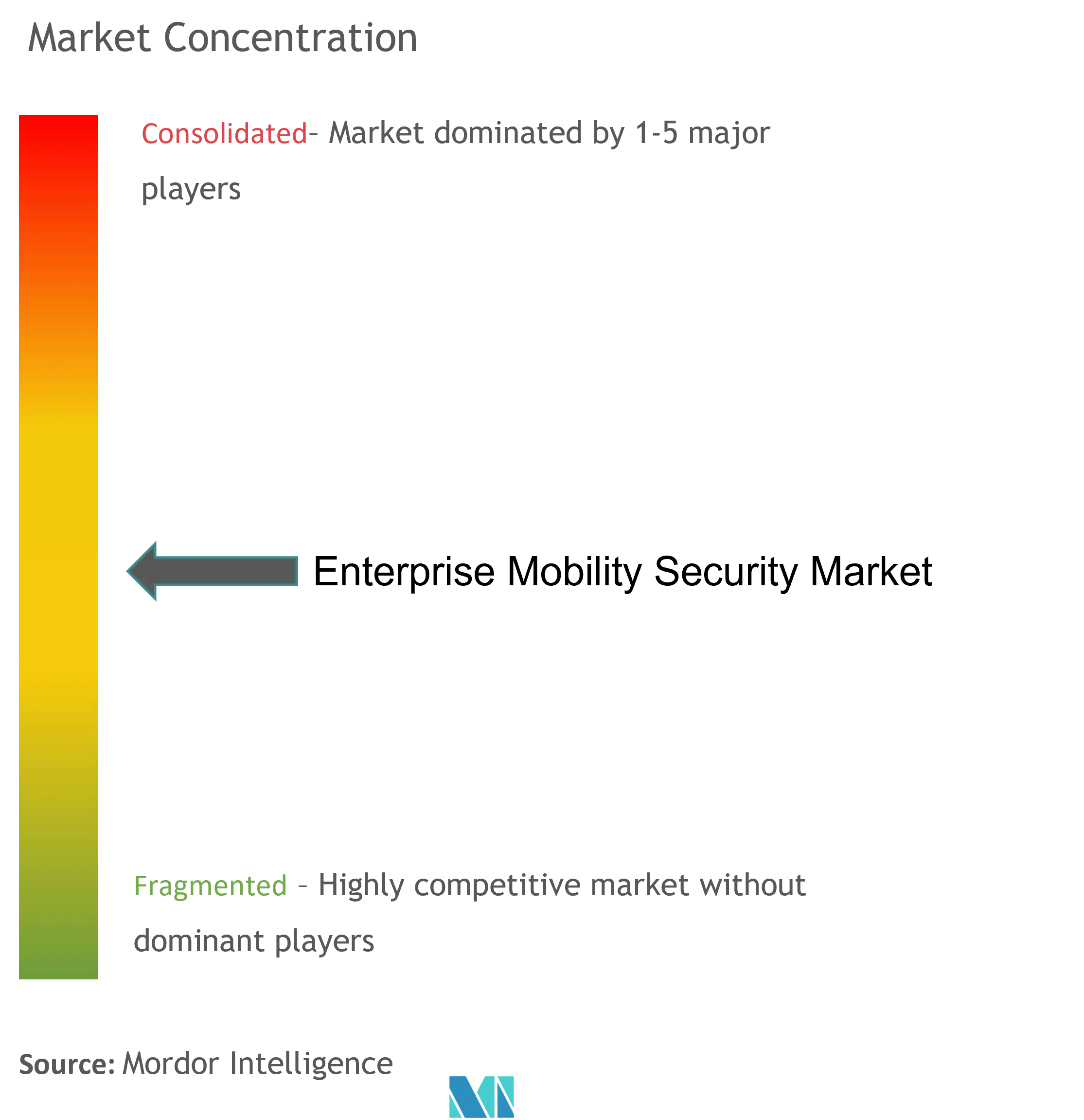
Enterprise Mobility Security Market News
- October 2022: Mobliciti provides enterprise mobility, security, and wireless connectivity solutions. Kocho, a UK-based provider of managed services in cyber security, identity management, and cloud transition, acquired Mobliciti. By incorporating strategic mobile management and security capabilities, the partnership would enable Kocho's service offering and customers of both businesses to access a comprehensive lineup to accelerate the pace of their digital transformation activities.
- July 2022: CWSI accelerated its UK growth by purchasing AVR International for EUR 5.2 million. AVR International has 20 years of experience providing technical advice, professional services, and support for various leading security and enterprise mobility solutions. AVR's premium clientele, including one of the world's biggest private hospital groups, would have access to a wider range of services due to CWSI's acquisition of AVR.
Enterprise Mobility Security Industry Segmentation
Enterprise mobility security (EMS) addresses the need for securing the devices while providing greater agility brought on by a shift from the traditional central office business model among enterprises.
The Enterprise Mobility Security Market can be segmented by Device (Smartphones, Laptops, Tablets), End-user Industry (Banking/Insurance, Healthcare, IT and Telecom, Government), and Geography (North America, Europe, Asia-Pacific, Latin America, and Middle East and Africa). The market sizes and forecasts are provided in value (USD million) for all the above segments.
The Enterprise Mobility Security market is expected to grow at a CAGR of 33.8 % during the forecast period.
| By Device | Smartphones |
| Laptops | |
| Tablets | |
| By End-User | Banking/Insurance |
| Healthcare | |
| IT and Telecom | |
| Government | |
| Other End-user Industries | |
| Geography | North America |
| Europe | |
| Asia-Pacific | |
| Latin America | |
| Middle East and Africa |
Enterprise Mobility Security Market Research FAQs
How big is the Enterprise Mobility Security Market?
The Enterprise Mobility Security Market size is expected to reach USD 1.35 billion in 2025 and grow at a CAGR of 11.70% to reach USD 2.35 billion by 2030.
What is the current Enterprise Mobility Security Market size?
In 2025, the Enterprise Mobility Security Market size is expected to reach USD 1.35 billion.
Who are the key players in Enterprise Mobility Security Market?
Blackberry, MobileIron, AirWatch, Citrix Systems Inc. and Microsoft Corporation are the major companies operating in the Enterprise Mobility Security Market.
Which is the fastest growing region in Enterprise Mobility Security Market?
Asia Pacific is estimated to grow at the highest CAGR over the forecast period (2025-2030).
Which region has the biggest share in Enterprise Mobility Security Market?
In 2025, the North America accounts for the largest market share in Enterprise Mobility Security Market.
What years does this Enterprise Mobility Security Market cover, and what was the market size in 2024?
In 2024, the Enterprise Mobility Security Market size was estimated at USD 1.19 billion. The report covers the Enterprise Mobility Security Market historical market size for years: 2019, 2020, 2021, 2022, 2023 and 2024. The report also forecasts the Enterprise Mobility Security Market size for years: 2025, 2026, 2027, 2028, 2029 and 2030.
Our Best Selling Reports
Enterprise Mobility Security Industry Report
Statistics for the 2025 Enterprise Mobility Security market share, size and revenue growth rate, created by Mordor Intelligence™ Industry Reports. Enterprise Mobility Security analysis includes a market forecast outlook for 2025 to 2030 and historical overview. Get a sample of this industry analysis as a free report PDF download.



